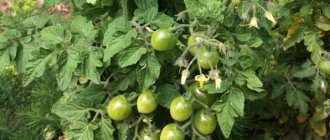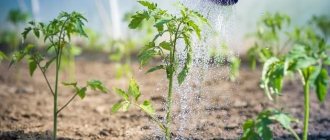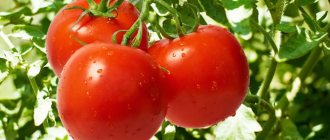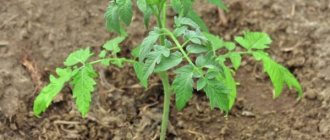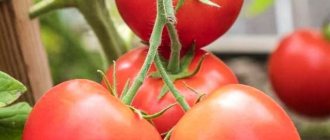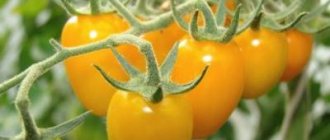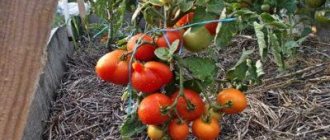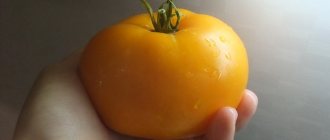Description and characteristics of the variety
“Ultra early ripening” was developed by breeders from Siberia. That's why it feels great throughout Eurasia. Its most characteristic features are:
- super-early ripening variety: begins to bear fruit 70 days after the seeds emerge from the ground;
- suitable for both growing in greenhouses and open ground;
- standard bush of determinate type: grows up to 55-70 cm in height;
- fruits are round in shape, weighing up to 100 g, usually bright red in color;
- one brush can contain up to 8 ovaries;
- the fruits have dense pulp with a small number of seed nests, due to which they tolerate storage and transportation quite well;
- the peel is dense, shiny, the taste is sweet;
- has high productivity. With proper care, one bush produces approximately 2 kg of fruit, and from 1 sq. m you can collect up to 13-14 kg of tomatoes;
- Due to its high early maturity, it is resistant to most diseases and pests.
What varieties of tomatoes are called ultra-early ripening?
The gradation between groups of varieties according to ripening time is quite arbitrary: it is clear that the speed with which tomatoes ripen is significantly influenced by both the weather and the care they take. Of course, fluctuations in the ripening time in one direction or another are possible, up to a week. Nevertheless, conventional boundaries between groups of varieties exist.
Thus, late-ripening varieties are considered to be those varieties whose fruits can be harvested no earlier than 130 days after germination, and early-ripening tomatoes are ready for the first harvest after about three months. In this important group, those varieties that ripen very early are especially distinguished: they are called super- or ultra-early. Their fruits can be tasted approximately 75–85 days after emergence, that is, a little earlier than three months after sowing the seeds for seedlings or directly into the garden bed.
Early-ripening and ultra-early-ripening varieties are especially attractive in cold regions, where other tomatoes, even in a greenhouse, often do not have time to fully produce the entire possible harvest. They are also interesting for farmers who grow tomatoes for sale: after all, it is in spring and early summer that fresh vegetables are most valued, at this time the body has not yet been saturated with vitamins and asks for “something tasty.”
Photo gallery
Varieties for greenhouses
Pumpkin - bushes 60-65 cm high are formed into 2-3 stems, constantly removing side shoots. The harvest ripens abundantly, so each stem is tied to a support. The weight of ripe tomatoes is 140-150 g. The variety is unpretentious - the bushes grow well in different soils and do not require frequent irrigation of the soil.
The Gardener's Dream is characterized by abundant harvests. Approximately 5 tomatoes weighing 160-175 g are tied in a brush, flattened in shape, with dense skin. Quite spreading branches grow on stems 60-65 cm high, so regular formation is required.
Typhoon F1 - lush bushes grow above two meters, so they need tying and shaping. A cluster holds 6-8 tomatoes, ripening weighing 70-85 g. The pulp is tasty, the harvest is most often canned or used for making juices, sauces, and pastes.
Trapeza belongs to indeterminate varieties - the stems grow to a height of 1.8-2 m, so they need reliable support and constant tying. The elongated fruits ripen in 85-87 days, they are small in size - they weigh up to 18 g. The advantages of the variety are resistance to drought, the fruits can be stored for a long time, the plant is resistant to diseases.
Pros and cons of the variety
- The advantages of the “ultra-early ripening” variety include:
- rapid ripening of fruits almost simultaneously;
- unpretentiousness;
- developed immunity;
- tolerates short-term frosts, sudden changes in weather and low temperatures;
- You can preserve whole fruits.
- This variety has few disadvantages, but they do exist:
- the need to tie up plants, since due to the abundance of fruits, untied stems may break;
- some complexity of stepsoning.
Did you know? In order to protect young seedlings from night frosts after planting in open ground, you need to water well between the rows at night. The temperature contrast between the warm soil, heated by the daytime sun, and the cold of the night causes fog to appear, which protects the bushes from frost.
Features of the variety
The tomato with the self-explanatory name “Ultra-early ripening” is a very early variety, in which the first fruits appear on the 70-75th day of the growing season. And after another 8-10 days, the tomatoes enter biological maturity - they acquire a unique rich taste and fresh tomato aroma. Only a few tomato varieties can boast of such early harvest ripening. This variety was developed by Siberian agronomists, who tried to provide their brainchild with half a dozen more positive qualities. One of them is the unique ability of plants of this variety to grow in almost any climatic conditions. Thanks to this, “Ultra Early Maturing” is happily planted en masse by both southerners and Siberians. And they always get excellent harvests.
Information: the “Ultra-Early Maturing” variety has not yet been included in the State Register of the Russian Federation.
One of the advantages of the tomato is the structure of the bushes of its plants. Ultra-early ripening belongs to the group of determinate varieties, that is, the bushes grow no more than 90 centimeters in height, and then stop growing on their own. True, the bushes are overgrown with dense foliage and spreading branches, and therefore look three-dimensional. It is impossible to do without gartering the main stem and branches heavy with numerous fruits.
Each plant forms 3-4 brushes, on which simple inflorescences are formed. Each cluster bears 6-8 fruits. The tomatoes are small, oval in shape. It is noteworthy that all the fruits are the same size and weigh approximately the same, 100-120 grams each. The skin of the tomato is strong, dense, and glossy. When fully ripe, it is colored bright red. The pulp is juicy, sweetish, without sourness. Due to their dense structure, tomatoes of this variety can be stored for a long time and can withstand the load during transportation.
Ultra-early ripening fruits are not prone to cracking. And even after heat treatment they look great. That's why housewives love to use these small tomatoes for whole-fruit canning and various marinades.
Please note : you might think that the Ultra Early Maturing variety is a hybrid, since it has properties usually associated with crossed varieties.
However, scientists assure that Ultra Early is a pure variety that can be grown from its own seeds.
Tomato plants almost never get sick. Moreover, they are not susceptible to infection even by late blight. And all because the crop ripens very early, and the harmful disease does not even have time to develop.
Tomato bushes feel great both in open sunny areas and in greenhouse beds. Caring for them is simple and not labor-intensive.
A story about such a wonderful variety would be incomplete without a description of its productivity. And she, by the way, is beyond praise. From one square meter (on which an average of 5-6 bushes are placed) you can collect up to 15 kilograms of quality fruits
Advantages of the variety:
- very early;
- the fruits are all the same size;
- excellent tomato taste;
- resistant to diseases;
- all the fruits ripen at once;
- can be grown from your own seeds.
The variety has no disadvantages. And if any roughness appears when growing this type of tomato, it most often occurs due to the gardener’s carelessness and inability to properly cultivate this delicate crop.
Features of planting and growing
Almost all the rules for growing tomatoes of other varieties apply to “ultra-early ripening” tomatoes, but there are some differences.
In the open ground
You can grow “ultra-early” in open ground with both seedlings and seeds. The south of Russia and almost the entire territory of Ukraine are quite suitable for growing without the use of greenhouses. This method, under favorable weather conditions, is applicable to most of Belarus and central Russia.
Important! When choosing a place for beds for future tomatoes, you should remember that this crop feels good after carrots, beets, onions, and cabbage. They take root well after cucumbers, but tomatoes grow poorly after peppers, legumes and tomatoes.
For this variety, the most preferred soil types are sandy or clayey. If the acidity of the soil is high, in the fall, before digging, you should add lime or chalk to the soil.
Shortly before digging up the garden in the spring, future beds are treated with copper sulfate. From organic matter, you should use humus or compost (about 3 liters of humus per 1 bush).
To grow seedlings, seeds are sown in late winter-early spring (it all depends on the specific climatic features of your climate zone). A special mixture is used as a substrate, which can be bought in a store or prepared independently in this way:
- Take peat, sand and turf in equal parts. Mix the mixture thoroughly and bake in the oven for 20 minutes at a temperature of +180°C-+190°C (soil layer 4-6 cm). You can treat the substrate with boiling water and potassium permanganate (rich color), and then again with plain boiling water.
- Pour the dried mixture (slightly damp) into seedling containers with holes for drainage.
- Prepare fertilizer from 0.5 tbsp. spoons of superphosphate, 1 teaspoon of potassium sulfate and 0.5 tbsp. spoons of urea dissolved in 5 liters of water.
- Pour the resulting solution into the soil mixture and wait until the excess liquid drains through the holes.
Before planting, seeds are treated with growth stimulants or a weak solution of potassium permanganate.
It is more advisable to use boxes of a suitable size for growing seedlings, which are covered with soil, where grooves are made about 1.5-2 cm deep. You can put the seeds in the same boxes on a flat, damp soil surface, then sprinkle with a layer of soil mixture (1-1.5 cm ). Find out if you can grow tomatoes on the balcony at home.
The box is covered with garden film, which is removed periodically. The soil should be constantly slightly moist. Water the seedlings between the beds. If the soil is waterlogged, the film is removed for a while (until the soil reaches a normal level of moisture), and the boxes are placed in a warm place. An indicator that there is enough moisture is light evaporation on the inside of the film.
Until the first shoots sprout, you should carefully monitor the temperature regime (+23°C-+25°C), but when the sprouts appear, you will need to take care of sufficient lighting. A window sill without drafts is best suited.
When the seedlings reach 2.5-3 cm, they need to be pricked. Select the strongest shoots (if there are too many sprouts) and plant them in separate cups (preferably in peat cups).
After the seedlings have become stronger (by this time there should be at least some sunny spring days), they need to be hardened off. To do this, on the right day you need to open a window or take the seedlings out onto the balcony. For starters, 5-7 minutes is enough, gradually increase the time. The main thing in the procedure is to avoid drafts.
Important! If the seedlings have already reached the condition required for planting in the ground, but the weather conditions do not yet correspond to this, put them in a cool place and reduce the amount of watering - growth will slow down. After the plants find themselves in favorable conditions, they will again begin to confidently increase their growth.
By the time the seedlings reach the size required for planting in the ground (seedling height - 25-30 cm, stem thickness - 5-6 mm), beds should already be prepared in the garden, which have already been treated with chalk or lime since the fall (this procedure reduces its acidity ).
Remove weeds, dig up and apply the following fertilizers:
- humus - 3.5 l / 1 sq. m;
- superphosphate - 1.5 tbsp. l. / 1 sq. m.
Spring procedures (after the soil has been dug up) is also the following process: future beds are filled with a solution of bird droppings (400-450 g / 1 sq. m), a solution of wood ash of the same concentration and a solution of ammonium sulfate (15-18 g / 1 sq. m). Choose the concentration of the solution yourself. If the soil is sufficiently moist, dissolve the fertilizer in a small amount of water. If good watering is necessary, you will need a solution of lower concentration, but with a larger volume of water.
It is advisable to place the beds from north to south. This arrangement provides better illumination. The distance between adjacent holes (as well as between rows) should be 45-50 cm. After the beds are marked and the holes are made, treat everything first with a strong solution of potassium permanganate in boiling water, and then with regular boiling water.
It is recommended to plant seedlings on a slightly cloudy, windless day. Deepen the stem with the root system into the hole by 5-7 cm, then cover it with substrate, lightly compacting it. Plants should be watered with warm water.
Tomatoes of the “ultra-early ripening” variety can also be planted with seeds in open ground. They tolerate light spring frosts well. The advantage of this method: the plant becomes more resistant to frost, diseases and pests.
As for arranging the beds, this procedure is no different from the one described above (for planting by seedlings). But the seeds require more complex preparation.
Did you know? South American Indians cultivated tomatoes more than 2,800 years ago. They called the plant a “large berry,” which in the original sounded like “tomatl.”
Before planting, seeds should be treated with “Immunocytophyte” (1/2 tablet per 500 ml of water) or nitrophoska (1/4 tsp for the same amount of water) in this way: thoroughly moisten a small terry towel with the resulting solution and spread the seeds on it. Roll up the towel and place it in the refrigerator for 72 hours.
Then remove the roller from the refrigerator, soak it again in the solution, wrap it in cling film (it will prevent the moisture from evaporating) and keep it indoors for the same amount of time.
Sowing seeds in the ground should be carried out (depending on the region) approximately in the second ten days of May. Drop 3 sprouted seeds into the prepared holes, add 1/2 tsp. urea and humus.
Video: Sowing tomato seeds in open ground
If it’s still cool (or you live in the northern part of Russia or Belarus), you can install a transparent plastic bottle upside down over each hole - a kind of mini-greenhouse.
The space between the holes can be mulched or insulated with straw. When the seedlings sprout and get stronger, they are picked, leaving the strongest ones. The method of planting seeds in the ground is not very reliable. Due to sudden frosts or non-germination of seeds, you may miss planting time and be left without a harvest.
The advantages of the method (viability, fruiting) have already been discussed above. So if the area of your plot allows, try both methods - then you will get an “ultra-early ripening” tomato harvest for longer. First, bushes planted with seedlings will begin to bear fruit, and then by seed.
In the greenhouse
To grow tomatoes in a greenhouse, you can use the following scheme: do everything the same as when growing seedlings until the moment of picking, only during the picking process, plant the shoots not in cups (pots), but directly in the greenhouse.
Did you know? With proper cultivation of tomatoes in a greenhouse, you can get a yield 2.4 times greater than when grown in open ground.
Before planting seedlings, it is necessary to prepare the beds. It is more advisable to do this 6-8 days before the planned disembarkation date. Create beds along the entire length of the room (the number depends on the size of the greenhouse).
Approximate dimensions of the beds:
- width - 60-85 cm;
- height - 35-45 cm;
- Row spacing is 55-65 cm.
Then prepare the substrate for future tomatoes. If the greenhouse has loam, it is necessary to add humus or ash (8-9 kg / sq. m). The peat substrate should be covered with sawdust (in the same quantity). As for mineral fertilizers, it would not hurt to add 15 g of potassium sulfate and 30 g of superphosphate per 1 sq. m. m.
After introducing fertilizers, the beds should be dug up, and before planting seedlings, water them with a solution of potassium permanganate (1 g per bucket of water, temperature - about 65 ° C).
3-4 days before planting, remove the 3 lower leaves. This promotes better aeration and reduces the likelihood of developing various diseases. When transplanting seedlings into a greenhouse, you should remember some simple but important recommendations:
- the substrate must be warm (+13°C-+16°C), garden film should be used to heat it;
- relative air humidity - no higher than 60-65%;
- The depth of the holes should not exceed 8 cm.
- You should not use a lot of nitrogen fertilizers, otherwise you will end up with a green garden with a minimum amount of fruits;
- “Ultra-early ripening” is best planted in a checkerboard pattern, the distance between holes is about 40 cm.
Advantages and disadvantages of ultra-ripe varieties
The possibility of obtaining an early harvest is the main advantage of the varieties. However, cultures have other advantages:
- early-ripening tomatoes do not suffer from late blight, since the main peak of infection is late summer-early autumn, when wet weather is often combined with a decrease in air temperature;
- The first tomatoes have a delicate aroma and a unique rich taste. As a rule, vegetables are consumed fresh or used for making fresh juice;
- ultra-early crops are characterized by high yields. Depending on the variety, a harvest weighing 7-17 kg is harvested per square meter of bed.
Depending on the preferences of the summer resident, early varieties with small fruits (such as cherry) can be planted, or tomatoes with a standard weight of 180-220 g will ripen.
Tomato care
To get a good harvest of tomatoes, it is not enough to simply plant high-quality seedlings in the ground or greenhouse. Tomatoes, like any other crop, require certain care. And although “ultra-early ripening” cannot be called a capricious variety, it still needs some care.
Important! You cannot grow tomatoes and cucumbers in the same greenhouse. These most popular garden crops have completely different optimal temperature and humidity conditions.
Fertilizer and watering
15-20 days after planting the seedlings in the ground, the first fertilizing should be carried out. Experienced gardeners recommend using this solution (per 5 liters of water):
- nitrogen fertilizers - 12 g;
- phosphorus - 20 g;
- potassium - 8 g.
This amount of solution is designed for 10 bushes. For subsequent fertilizing, complex mineral fertilizers are used. Tomatoes respond especially well to potassium.
Video: Feeding tomatoes
As for organics, you can use manure. You need to dilute 1 liter of manure in a bucket of water, then leave the solution for 1.5-2 weeks. After this time, you will feel a characteristic smell indicating the readiness of the fertilizer. Take 1 liter of the resulting infusion and dilute it in a bucket of water. Use the product at the rate of 1 liter per 1 bush.
Important! Remember that manure should not be overused as a fertilizer for tomatoes. The lack of minerals can be compensated for by additional application of the necessary fertilizers, but their excess is much more difficult to eliminate. A large amount of manure produces a lot of greenery, but few ovaries (and therefore fruits) are formed.
Tomatoes do not tolerate stagnation of water in the soil. This fact should be taken into account when watering plants. It is better to use this watering scheme. First: plenty of water, but not too often. Second: in moderate heat, one watering every 3-4 days will be enough.
Basic rules of watering:
- avoid getting moisture on the green mass of the plant;
- It is better to water in the evening;
- if it is cloudy outside, watering can be carried out during the day;
- use rain or settled water at a temperature above +20°C;
- Drip irrigation is the most effective.
Read more about the features of proper watering of tomatoes.
Bush formation and pinching
All leaf axils after the first can give rise to a new shoot (stepson) - a branch of the trunk, on which fruits and ovaries will also form. As a result, the plant will have a lot of green mass, but small fruits. To avoid this phenomenon, it is necessary to carry out stepsoning. This is the name of the process of removing excess stepsons.
Determinate varieties, which include “ultra-early ripening,” are more difficult to plant for the reason that you can remove a shoot that will continue the growth of the bush. This stepson (the main one) completes growth, and the final ovary appears at its end. If it is removed, new shoots producing ovaries will no longer appear.
Basic rules for growing “ultra-early ripening” tomatoes:
- In order for the desired shoot to remain intact, stepsoning should be carried out no earlier than the stepson grows to 4 cm. Before the procedure, it is necessary to determine which shoot will become the main one. If you are in doubt about whether to remove a shoot, it is better to leave it.
- It is advisable to plant the stepson in the morning. The shoot is broken off with your fingers (you should work with gloves so as not to transmit any infection to the wounded plant). You can also use a very sharp knife, but you need to act with the precision and determination of a surgeon.
- If you use a knife, after processing one bush, the tool must be disinfected (with potassium permanganate or bleach).
- The shoot is removed so that a cutting of 1-1.5 cm remains.
- Trimmed shoots are folded and removed from the beds to avoid diseases that they may cause.
Did you know? Currently, more than 9 thousand varieties and hybrids of tomatoes are known. The smallest tomato has a diameter of just over 1.5 cm; the weight of the largest is more than 1400 g. The color of ripe tomatoes can be yellow, red and even black.
Loosening the soil
It is best to loosen the soil after watering. This will prevent a crust from forming on the surface of the soil. At the same time, weeds should be removed. It is necessary to loosen the area near the trunk very carefully so as not to damage the root system. For the first three weeks, the soil is loosened to a depth of 7 cm, and even less near the trunk (3-4 cm). After the roots grow, the depth of loosening should be reduced.
Bushes should be hilled up from time to time. The first time they hill up 3 weeks after planting on the beds, then at the same frequency. This measure will prevent the roots from being exposed, prevent them from overcooling, and also contribute to the normal development of the root system.
Pollination
Tomatoes are a self-pollinating crop; They don’t need pollinating insects, although they won’t hurt them. To ensure pollination, during the flowering period, you can gently shake the shoots with flowers 2-3 times a week. To attract insects, bright flowers (for example, marigolds, calendula) are often planted nearby, which not only attract pollinators, but also repel parasites due to the substances they contain.
Reviews of some early varieties of tomatoes
Sanka is good for OG, why should he be in the greenhouse, to take up space. It grows up to 80 cm, although the annotation says that d.b. 40–60. Heavily leafy. I like that it has strong, even, dense fruits. And they’re not bad to eat or preserve. And the main thing is that in our conditions, it bears fruit in the exhaust zone.
Sirina
https://dacha.wcb.ru/index.php?showtopic=54259
For beginning amateur gardeners, I would advise you to first purchase tomatoes of the “Riddle” variety, and for those who cannot always pay proper attention to their plants, appearing on their garden plot once a week, this is the best variety.
Irina
https://otzovik.com/review_1339013.html
As for taste, “Riddle” is not suitable for people with refined tastes and gourmets at all. And the fact that she is short, in principle this plus is not so significant. Therefore, plant this variety only if you need to quickly get at least some harvest and organize modest nutrition on the site. You are unlikely to be able to surprise your friends and acquaintances with the “Riddle”.
Evgen
https://otzovik.com/review_1710278.html
I like the Betta tomato, but it has some drawbacks - the taste is not sweet, but good, poor disease resistance, the yield is no more than 5-7 large fruits, the rest are minor things. Pros: low tomatoes, you can plant them densely, up to 15 pieces per square meter. m, very early ripening, a variety for beginners, direct sowing in the ground in May, not affected by late blight, not sprouted. We plant no more than 5 bushes so that we can eat the fruits at the end of June.
Charlie83
https://forum.prihoz.ru/viewtopic.php?t=1669&start=45
BETTA. It can be sown for seedlings in early April! The variety is very beautiful - it will outshine many new varieties.
User6993
https://7dach.ru/MarinaGerasimenko/samye-rannie-sorta-tomatov-4191.html?c=3
I can only give positive feedback about the Amur Stamb variety. This variety is characterized by many excellent qualities.
Tiu
https://www.bolshoyvopros.ru/questions/2393275-tomat-sorta-amurskij-shtamb-kto-sazhal-opisanie-otzyvy-i-foto.html
Amur dawn. This year's opening variety. Very productive. The height of the bush in the OG is 60 cm. Beautiful round-flat, slightly ribbed red-crimson fruits on top, very densely strewn with slightly flimsy tops. They don't crack. Dense, tasty (to my taste).
Firefly
https://www.tomat-pomidor.com/forums/topic/2112-%D0%B0%D0%BC%D1%83%D1%80%D1%81%D0%BA%D0%B0%D1%8F -%D0%B7%D0%B0%D1%80%D1%8F/
Flash. Sowed in February for an early harvest. The first ones were filmed on 07/02/12. They grew up in a greenhouse. I thought they would give away the first harvest together and I would free up space in the greenhouse so that the Indians would not get in the way. But it was not to be, the Flash bore fruit tirelessly until frost. In the summer it was finished, but it produced stepsons and continued to bear fruit on them.
Cherry
https://www.tomat-pomidor.com/forums/topic/263-%D0%B2%D1%81%D0%BF%D1%8B%D1%88%D0%BA%D0%B0/
Resistance to diseases and pests
Despite the fact that the variety is considered resistant to various diseases and pests that usually attack tomatoes, spraying garlic and wormwood shoots with infusion can be used as preventive measures.
Late blight poses some danger . This happens in case of sudden changes in temperature and air humidity. To prevent this problem, plants are sprayed with Bordeaux mixture.
As for pests, it is worth mentioning the mole cricket and whitefly. If, nevertheless, they have chosen tomatoes, then Mospilan and Akellik have proven themselves to be effective means of control.
To protect against wireworms, use “Bazudin”: make a mixture of the drug and sand, which is placed in a small hole next to the tomato bushes where the wireworm has settled, and sprinkled with earth.
How to plant ultra-early tomato varieties as seedlings in greenhouses
How to plant ultra-early tomato varieties as seedlings in greenhouses
You can plant the Ultra-early tomato variety at an earlier date, in mid-May, only on the condition that it will grow in a greenhouse. There the seedlings will feel more comfortable. In order for the plants to adapt to the surrounding microclimate of the greenhouse, it is advisable to leave the containers with seedlings for a couple of days under a film cover; during the day it will be better if the boxes are open.
Ultra-early ripening tomato seedlings in a greenhouse - this is convenient, because if it suddenly gets colder, such a structure can be additionally covered with some kind of dense material. A large blanket works well. Typically, plants of this variety are planted in parallel in prepared holes, keeping a distance of about 40 cm between the bushes. There should be at least 70 cm between the rows.
Currently, there is a wide variety of greenhouse types. Both wooden, metal and plastic structures. Here it is also correct to choose those crops that will feel comfortable in a confined space.
How to make a greenhouse for Ultra-early ripening tomatoes
The building materials you will need are plastic pipes, supports, and spunbond. It is necessary to make machine stitches on the spunbond, forming folds with a hole. The lines are made at a distance of half a meter from each other. Then you need to insert plastic pipes into them, and drive pegs around the ridge, at the same distance from each other. Next, the pipes are simply put on the pegs, and you get a greenhouse. The design is very convenient to use, as it is easy to assemble and disassemble when necessary. In addition, the parts are inexpensive and can be easily replaced with new ones if necessary. If you just need to open the greenhouse a little, then the arcs fold as needed.
At the next stage, after transplanting the seedlings into a greenhouse, the plants must be watered and the soil on top must be mulched so that the moisture is better retained and the soil does not dry out. After a week has passed, tomatoes must be treated with special preparations to protect against late blight. Considering that tomatoes of this variety do not tolerate heat and excessive moisture, the greenhouse will need to be opened on especially hot days. Once the warm summer weather stabilizes outside, the structure can be removed.
Cooking recommendations
A few words should be said about the culinary characteristics of the variety:
- During heat treatment, the skin of tomatoes does not crack, so the variety is excellent for canning as a whole;
- Tomatoes of this variety are also good for fresh consumption, in salads;
- Due to the dense pulp (due to the low water content, long evaporation is not required) they are an excellent raw material for making juices, sauces, ketchup, and various home-made canned goods (borscht dressing, snacks).
Check out step-by-step instructions for canning tomatoes at home.
It can be said about “ultra-early ripening” tomatoes that they fully deserve praise. But in order for these tomatoes to fully justify the name of the variety, they should be grown in greenhouses or by seedlings.
Popular varieties for open ground
Early ripening tomatoes are always in demand among summer residents. After all, there is no need to build greenhouses, and an early harvest of vegetables is guaranteed. The most popular tomatoes:
- Agata - compact bushes do not grow higher than 45 cm, ripe tomatoes weighing 70-100 g appear 95-98 days after sowing the seeds. Up to 7 kg of round, flattened tomatoes are collected from the bush;
- Sanka - low bushes need support. Some gardeners do not tie up the plants, but the bushes become sprawling and can “fall apart” on the ground. 2-2.5 kg of early tomatoes are collected from the bush, which are canned and consumed fresh;
- Parodist - tomatoes ripen 80-84 days after seed germination. It is convenient to care for short plants (up to 50 cm);
- Betalux - harvesting begins in 80-85 days. Low bushes do not need to be pinched; fruits weigh 80-100 g. Smooth, round tomatoes are suitable for making fresh salads, juices, and canning.
An early-ripening tomato with the funny name Skovorodina is in demand. Strong stems grow to a height of 45-47 cm and do not require support or pinching at all. Round tomatoes of a rich pink hue ripen weighing 120-135 g.
Varieties for balconies
The hut is rich - dwarf bushes 35-45 cm high grow well on insulated balconies or on the windowsill. The smooth, slightly ribbed fruits are canned and added to fresh salads. The first harvest can be harvested 100-110 days after emergence.
The elegant Yellow Cap is ideal for planting on balconies in flowerpots and small flowerpots. Low-growing bushes do not need to be formed; the yellow fruits ripen, weighing 15-20 g. The harvest is harvested 80-85 days after germination of the seed.
Features of growing in soil
Of course, it is much more difficult to grow tomatoes in the ground than in a greenhouse. Whatever variety is selected for planting, it is always worth remembering that tomatoes are still plants that love warmth and moderate humidity. Therefore, under optimal weather conditions, you can grow a good harvest, but if the weather fails, you have to hope for luck. But it is still important to follow a number of rules to guarantee stable and good harvests.
- Plant seedlings correctly: so as not to be exposed to frost, but also not to expose the plants to the autumn cold if the seedlings are planted too late.
- Do not be too zealous in watering, tomatoes do not like excess moisture and begin to get sick.
- The soil must be loosened regularly and fruits that are already ripe must be picked in time.
- Feed plants and protect them from pests using special products.
- Any tomatoes need to be tied up, even if they are not very tall.
Compliance with these simple rules will help you grow a good harvest of tomatoes, and if you plant seeds of the indicated varieties, this will be a complete guarantee of excellent fruit harvests.
How does an ultra-early tomato differ from its other varieties? Of course, the ripening period. Early-ripening tomatoes ripen on average in 90 days, tomatoes with medium ripeness - about 115 days, and late-ripening - up to 130 days. Ultra-early ripening varieties can produce a harvest in 80 days. These tomatoes have many advantages.
The very first is the opportunity to harvest an excellent harvest even in open ground in a short time. Ultra-early ripening tomatoes are usually much hardier, which is especially important for Siberia and the Urals. Usually, among ultra-early ripening varieties and hybrids for open ground and film shelters, there are standard varieties that do not need to be pinched or formed into bushes. In many cases, tomatoes grow in open ground without support. Planting material using film covers can be grown without seedlings, which is very convenient. It is enough to prepare the seeds, plant them under non-woven material and germinate until the seedlings get stronger.
The advantage of ultra-early ripening tomatoes is their resistance to late blight.
Their harvest ripens faster than the period of widespread infection with this disease.
Growing and caring for early ripening varieties
The process of growing early ripening tomatoes is simple. You can use the seedling or seed method for this.
Growing seedlings
The process of sowing seeds is carried out as follows:
- Send the planting material into a container with fertilized substrate in March.
- Sow seeds to a depth of 2-3 cm.
- To keep the soil temperature constant, cover the container with glass.
- As soon as 2 true leaves are formed, pick. During this process, plant the plants in separate pots or in a greenhouse.
- Planting seedlings in open ground occurs only after the likelihood of frost returning has disappeared.
Planting in open ground
Before sending seedlings into open ground, harden them. 10 days before planting, place the seedlings on the balcony for 5-10 minutes, increasing the time interval by 5 minutes every day.
- Plant plants in holes or trenches. Maintain a distance of 40 cm between bushes.
- It is better to plant tomatoes in a well-lit place where there is no direct sunlight.
- Choose light and fertile soil.
After planting, plants need regular moisture. For irrigation, use only warm and settled water. It is best to irrigate in the evening. Feed plants with potassium fertilizers. Apply them once every 2 weeks after watering.
You can prevent contamination of tomatoes and make harvesting easier by tying up the bushes. Pinching will allow the plant to direct all its forces to the development of fruits, and not the growth of stems.
To better understand what ultra-early ripening tomato varieties for greenhouses look like, you can look at the photographs below.
You can also watch this video, where an experienced gardener will tell you about the Ultra-early variety.
Ultra-early ripening varieties of tomatoes for greenhouses are a frequent choice of gardeners. Their main advantages: high and early yield, strong immunity to diseases and ease of care. And the sweet taste and pleasant aroma of such tomatoes will only add to their popularity.
